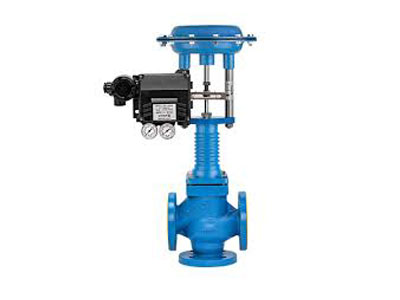What Is The Principle Of Control Valve?
Key Takeaway
The principle of a control valve involves regulating the flow of fluids by adjusting the size of the flow passage based on a signal from a controller. A controller (such as a PLC or DCS) sends a signal that commands the valve to either open or close, allowing precise control over process variables like flow rate, pressure, and temperature.
The control valve works by using an actuator to change the position of the valve, thereby adjusting the flow of liquids or gases. It ensures the system operates efficiently by maintaining desired conditions and compensating for disturbances, ensuring optimal system performance.
Basic Working Principle of Control Valves
The control valve operates by altering the flow passage size, using a movable plug or disc inside the valve body. This plug adjusts the flow path based on signals from a controller.
Key components include:
Valve Body: Contains the flow path and plug.
Actuator: Provides the force to move the plug.
Positioner: Ensures the plug reaches the correct position based on the control signal.
For instance, in an industrial cooling system, the control valve adjusts the coolant flow to maintain the desired temperature. The controller sends signals to the actuator, which moves the valve plug to achieve the required flow.
This principle ensures precise flow regulation, making control valves indispensable in modern fluid systems.

How Control Valves Regulate Fluid Flow
Control valves regulate fluid flow by responding to signals from a controller. These signals dictate how much the valve should open or close, depending on process requirements.
The regulation process involves:
1. Receiving Input Signals: From sensors monitoring system parameters like pressure or temperature.
2. Actuator Movement: Translating signals into physical motion to adjust the valve.
3. Flow Adjustment: Changing the fluid flow rate to achieve the desired output.
For example, in a chemical processing plant, control valves manage the flow of raw materials into reactors. If the temperature exceeds the setpoint, the valve reduces the flow to stabilize the reaction.
Control valves ensure precise adjustments, critical for processes requiring stability and accuracy. Their ability to respond dynamically to changes makes them essential in fluid control systems.
The Role of Actuators and Positioners in Control Valves
Actuators and positioners are crucial for the smooth operation of control valves. They work together to translate control signals into precise valve movements.
1. Actuators:
Pneumatic Actuators: Use compressed air to move the valve stem.
Electric Actuators: Powered by electricity, ideal for remote operations.
Hydraulic Actuators: Use fluid pressure for high-force applications.
2. Positioners:
Act as intermediaries, ensuring the valve reaches the exact position specified by the control signal.
Improve accuracy, especially in systems requiring frequent adjustments.
For instance, in a power plant, actuators adjust steam flow through turbines, while positioners ensure precise control, enhancing energy efficiency.
Without these components, control valves would struggle to maintain accuracy and responsiveness, leading to system inefficiencies. Their integration ensures reliable performance in demanding environments.
Factors Affecting Control Valve Performance
Several factors influence a control valve’s efficiency and reliability:
1. Valve Design: The type (globe, ball, butterfly) determines flow characteristics.
2. Fluid Properties: Viscosity, temperature, and corrosiveness affect valve selection and performance.
3. Actuator Compatibility: Choosing the right actuator ensures smooth operation.
4. Maintenance: Regular upkeep prevents wear and tear, extending the valve’s lifespan.
5. Environmental Conditions: Temperature extremes, humidity, and dust can impact functionality.
For example, in oil refineries, control valves handle high-temperature and high-pressure fluids. Selecting robust materials and designs minimizes performance issues.
Addressing these factors ensures that control valves function optimally, reducing downtime and maintaining system stability.
The Importance of Valve Sizing in Control Systems
Proper valve sizing is critical for ensuring efficient control valve operation. A valve that’s too small may restrict flow, causing pressure drops, while an oversized valve could lead to poor control and instability.
Key aspects of sizing include:
1. Flow Requirements: Understanding the maximum and minimum flow rates the system demands.
2. Pressure Drop: Calculating the pressure difference across the valve during operation.
3. Cv Rating: The valve’s flow coefficient, indicating its capacity to pass fluid.
4. Fluid Characteristics: Considering factors like density, viscosity, and temperature.
For instance, in HVAC systems, improper sizing can lead to uneven temperature control and energy inefficiency. Engineers use sizing formulas and software to ensure the valve matches the system’s needs.
Accurate sizing optimizes performance, prevents operational issues, and extends the valve’s service life, making it a fundamental step in control system design.
Conclusion
Control valves play a vital role in regulating fluid flow and ensuring system stability. By understanding their principles, key components, and factors influencing performance, engineers can make informed decisions for optimal system design.
Proper sizing, regular maintenance, and selecting the right actuator and positioner are essential for achieving efficiency and reliability. Whether it’s a chemical plant, HVAC system, or power plant, effective control valve operation enhances safety, reduces energy consumption, and ensures long-term success.

